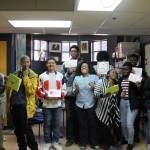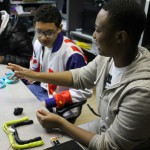If you were to ask an educator to name one of the biggest trends of today, they might point to the ever-increasing number of programs on campuses dealing with entrepreneurship and innovation. UMass Lowell has been a leader in this movement, with its DifferenceMaker program set to host its sixth Idea Challenge this spring, awarding $50,000 in prize money to deserving student teams that generate (and sell) ideas with appeal and potential.
In an effort to further prepare our students for the Idea Challenge, the Francis College of Engineering hosts a Prototyping Competition each Fall. The finals were held last week, with winning prototypes that included an inexpensive wound dressing for use in the field; a smart pill dispenser; an automated paint mixer (matching color to a digital picture); and an app for students to more easily find a job on campus. As novel as the potential products were, I saw more potential in the students – ranging from freshmen to graduate students from across the University. They were not competing because it involved a grade or was required – they were participating because they had an idea that they wanted to pursue and share.
A few years ago, UMass Lowell was invited to be an inaugural participant in the Pathways to Innovation program created by the NSF-funded Epicenter and VentureWell. It was through this program that entrepreneurial endeavors, such as our Prototyping Competition and Interdisciplinary Senior Design Program, were started. It was also through this program that faculty, such as Dr. David Willis of Mechanical Engineering, were encouraged to integrate innovation and entrepreneurship into the engineering curriculum.
Yesterday, I attended our MECH.1070 Project Expo – 45 teams of Mechanical Engineering freshmen showing off products built in their “Introduction to Mechanical Engineering” class (taught by Dr. Willis). Specifically, students were asked to build a CNC (Computer Numerical Control) machine. While we normally think of a CNC machine as a lathe or mill, the students were tasked with being creative and turning their 2- or 3-axis machines into something “useful”. Cleverly coupled with multiple sensors, I witnessed machines that: read text and printed braille; dispensed ideal amounts of toothpaste and mouthwash; folded a shirt; dispensed medication; mixed vaccines; played chess; and whimsically made peanut butter and jelly sandwiches (just to name a few projects). I learned, and laughed, and was extremely impressed, as each team “pitched” the value of their product.
It was clear that the students had learned a lot – about design (and CAD), manufacturing (machining and additive), and control (sensors and lots of MatLAB code). But it was also clear that the students had fun – and had a purpose. When asked about their motivation, they all had good answers – usually wanting to solve a problem or making the world a better place. That is the power of innovation.


